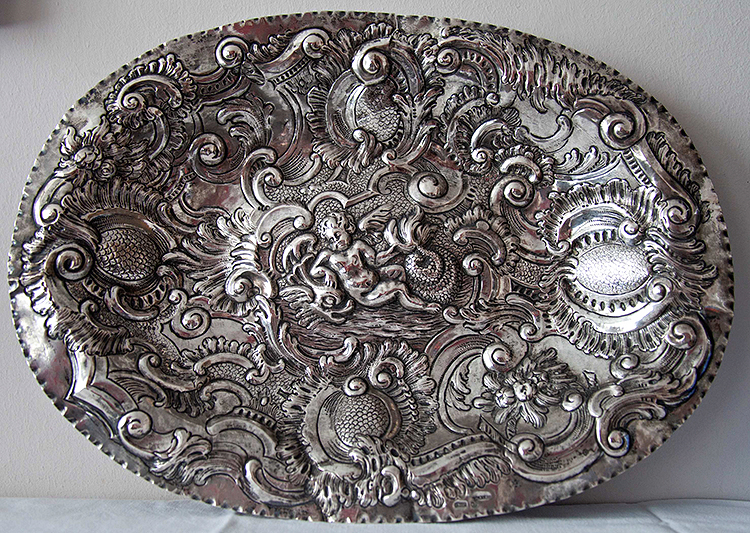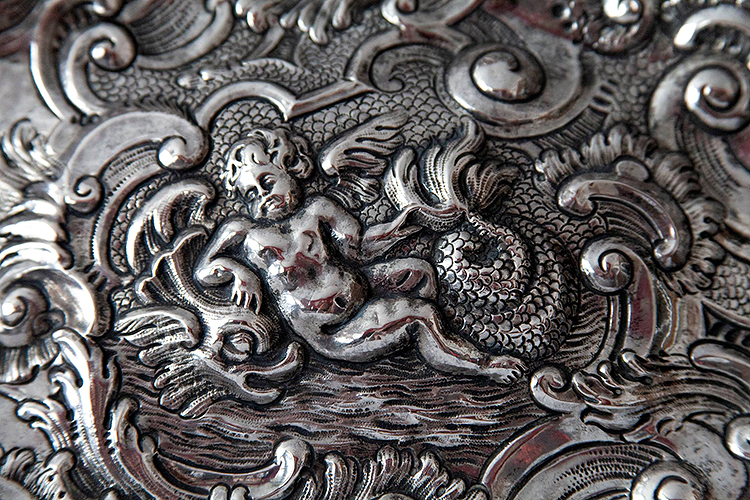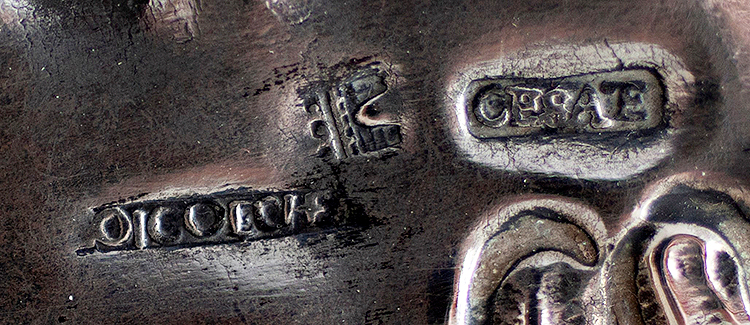The piece of the month of September 2023
SILVERWARE OF THE GOLDSMITH FROM ZARAGOZA ANDRÉS GOICOECHEA
Iñigo Serrano Sagaseta of Ilurdoz
In a private collection in Pamplona, and coming from the art market, there is a silver plate, measuring 5.5 x x cm, carved by the Zaragozan goldsmith Andrés Goicoechea. It corresponds to the model of the historiated cup that was so common in the Hispanic workshops throughout the 18th century, articulated by means of a straight border with a molded mouth, a concave field and a convex and historiated button or emblem. It is decorated with a profuse ornamentation of vegetal elements, floral garlands, rocailles and oval mirrors, the latter located on the axes of the field, which are distributed over the entire surface and blur the architectural lines of the piece.

Azafate Zaragoza
In the emblem there is a scene of a putto, with fleshy Anatomy, leaning on a dolphin, with its head turned towards the putto and its tail curled on itself. It is a mythological motif of frivolous character that follows the tradition of angels and putti in playful attitudes with humans and animals, in the line of Roman sculpture later recovered by the Baroque. In the church of Santa María de Tafalla, in Navarre, there is an unknown author's faience, since it has no marks, and more advanced in time, in which we see the same motif as in the one studied here, a putto lying on a dolphin, but with different plastic treatment in terms of the representation of the figures. The scenes of putti in different attitudes and accompanied by both human and animal figures are recurrent in the faience of the period, as we can see from the examples preserved from different peninsular workshops. Thus, we find putti in a faience of the church of the Magdalena in Zaragoza, work of Diego Lacasa; in the faience of a private collection carved by Miguel de Lenzano, whose motif will be repeated in his examination to obtain the degree scroll of master by his disciple Lorenzo Laoz; and in those of the convents of Segura, in Guipúzcoa, and Tulebras, in Navarra, all of them carved by silversmiths from Pamplona.

Detail
This model of azafate is common in Hispanic silverware centers throughout the eighteenth century, not only in the workshops of Zaragoza or Pamplona, especially from the second half of the century. There are several examples of Zaragoza preserved, such as those of the churches of La Magdalena, carved by Diego Lacasa menor, or of San Carlos, the work of Blas Castillo, the latter with the same marks of locality, or one from a private collection carved by Juan Dargallo. Following this model we can find saucers in other Hispanic workshops such as Cordoba, Toledo, Salamanca or Pamplona. In this last center they reached special importance, being one of the typologies chosen as test of examination by the guild of silversmiths of the city so that they were drawn, and later carried out, by the aspirants to obtain the Degree of master silversmith.
The boom that these pieces experienced in Pamplona, as well as the adaptation of this model, is not due to the influence of the neighboring center of Zaragoza, since the relationship of the Aragonese capital with Pamplona was scarce, being much more important and direct with Tudela and the Navarrese riverside. In the pieces carved by the Pamplona silversmiths we can see how in the first half of the century designs with vegetal decoration predominate, as can be seen in the Pamplona Silversmiths' Drawing Book, as well as in the preserved examples, while from the middle of the century onwards the historiated examples predominate.

Brands
This piece presents the triple mark used in Zaragoza: locality, contrast and author. The first, CESATE, with the T and E cast, corresponds to the Zaragoza punch variant in use in the city in the second half of the 18th century. The second, a castle, was the punch used by the Zaragoza contrasts between 1770 and 1790. And the third, GOICOECHEA, corresponds to the silversmith Andrés Goicoechea, a master from Zaragoza who is documented in 1776 working for the church of Nuestra Señora del Portillo in the city, for which he renovated an old lamp and made a new one invoice. Alejandro Pastor, a native of Teruel, was apprenticed to this silversmith for about four months. After passing through the workshops of different silversmiths in Zaragoza, he moved to Pamplona, where he trained with Miguel de Lenzano and Pedro de Aguinagalde, until he took his exams in 1776, precisely with the drawing of a lamp holder.
The piece was incorporated into the private collection to which it belongs from the market, so the original provenance of this saucer is unknown. As we can see, it was a common type of device in Hispanic houses and many of them were donated to different temples, where they were used as representational pieces, without a function within the liturgy, except to present textiles to the priests. Given their decoration, with marine elements of a mythological nature, their origin should be sought in a civil commissioner, although many of these works ended up being donated to the Church, as we can see in the azafates of Tulebras and Tafalla already mentioned, which present similar scenes.
SOURCES AND BIBLIOGRAPHY
ESTEBAN LORENTE, J. F., "El punzón de la platería y de los plateros zaragozanos desde el siglo XV al XIX", Cuadernos de research. Geography and History, Volume 2, Fasc. 1, Logroño, University of La Rioja, 1976.
ESTEBAN LORENTE, J. F., La platería de Zaragoza en los siglos XVII y XVIII, Zaragoza, 1981.
GARCÍA GAINZA, M.ª C., Dibujos antiguos de los plateros de Pamplona, Pamplona, EUNSA, 1991.
MIGUÉLIZ VALCARLOS, I., "Azafates pamploneses historiadoses de la segunda mitad del siglo XVIII", Príncipe de Viana, nº 244, Pamplona, Government of Navarra, 2008.
MORALES SOLCHAGA, E., Gremios artísticos en Pamplona durante los siglos del Barroco, Pamplona, Gobierno de Navarra, 2015.
